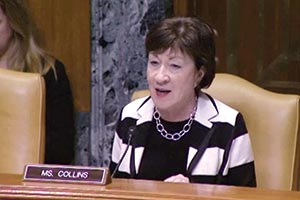Senior Reporter
Senators Endorse Safety Potential of Autonomous Driving Technology

This story appears in the Nov. 21 print edition of Transport Topics.
The advancement of autonomous trucks and cars would dramatically improve safety and reduce congestion along key freight corridors nationwide, the transportation funding leaders in the Senate said Nov. 16.
During an end-of-the-year hearing of the Transportation and Housing and Urban Development Appropriations Subcommittee, Chairman Susan Collins (R-Maine) touted the benefits the new technology would offer the nation.
“If this technology were to be perfected, automated vehicles could eliminate many of the crashes on our nation’s roadways and save thousands of lives each year,” Collins said, warning that federal regulators must keep up with the rate of innovation.
AUTONOMOUS AUTUMN: Recent video coverage of autonomous vehicle developments
“We must recognize that automated vehicle technology is advancing faster than government agencies can act. And in this instance, impeding the advancement of technology may prevent us from saving lives,” Collins added.
The subcommittee’s ranking Democrat, Sen. Jack Reed of Rhode Island, agreed that autonomous technology “is fundamentally changing vehicles as we know them.”
“This innovation has the potential to dramatically improve highway safety, as well as expand mobility access to thousands of people,” Reed said.
At the hearing, Deborah Hersman, president of the National Safety Council, stressed that policymakers need to establish a workable standard to guide the industry on development, testing and deployment. Without a standard, there would be a “flight of innovation in the United States, and the jobs that accompany it, to locations outside of our borders,” Hersman said.
Truck makers have been testing semi- and fully autonomous vehicles that could one day be incorporated into fleets. Executives have argued the new technology opens opportunities in fuel economy, safety and improvement in drivers’ quality of life.
Last month, technology firm Otto, a division of Uber, performed a heavy-duty delivery of beer for Anheuser-Busch InBev. The 133-mile route through Colorado mainly was performed by the truck’s autonomous systems, although a driver operated the truck for the first and last miles, before monitoring most of the trip from the sleeper berth.
In September, the National Highway Traffic Safety Administration issued policy guidelines on self- driving vehicles — cars and trucks. The agency indicated its people need more input to appropriately regulate vehicle makers. NHTSA officials asked automakers to submit comment on the best ways to regulate automated vehicles.
Trucking, led by American Trucking Associations President Chris Spear, criticized NHTSA’s recent guidelines on autonomous technology for not seeking industry input. Spear cited an American Transportation Research Institute report unveiled this month that he said underscored “how critical it is that the trucking industry have a seat at the table as autonomous vehicle issues are debated.”
“These impacts will be real and have significant consequences for the entire supply chain if they are not deliberately and thoughtfully approached with input from all stakeholders. Now is the time to make sure that autonomous vehicle technology is a win-win for the economy,” Spear said.
ATRI’s report, published Nov. 15, laid out possible ways the technology would affect the trucking industry. These included driver hours-of-service regulations, addressing the ongoing driver shortage and the adoption of electronic logging devices. ATRI also documented public-sector impediments to autonomous truck deployment, such as poor infrastructure quality.

